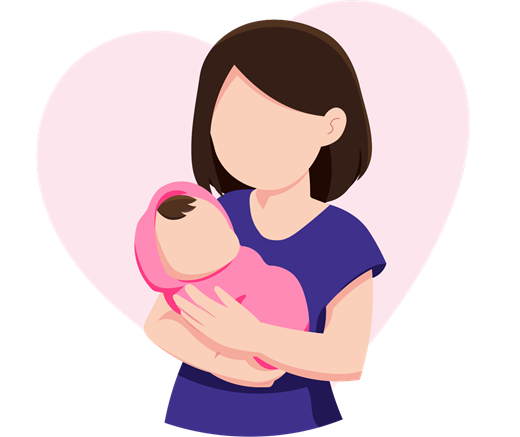
Preeclampsia
The Silent Intruder: Unveiling the Mysterious Condition That Affects Pregnant Women
In the realm of pregnancy, a lurking danger remains largely unknown to many: Preeclampsia. It affects 2-8% of expectant mothers worldwide [12], putting both the mother and the unborn baby at risk. As expectant parents prepare for the joyous arrival of their little one, Preeclampsia can unexpectedly cast a shadow over this joy. Understanding this enigmatic condition becomes crucial to safeguarding maternal health.
In this article, we delve into the symptoms, causes, and emphasise the crucial role of early detection in safeguarding maternal health.
What is Preeclampsia?
Preeclampsia, also known as toxaemia, is a hypertensive (i.e., high blood pressure) disorder in pregnant women. It is usually observed in women whose blood pressure was previously in the standard range after 20 weeks of gestation [1].
Prevalence of Preeclampsia
Preeclampsia affects between 2-8% of pregnancies worldwide, according to the WHO [12]. In India, it develops in 0.3 to 25.8% of pregnancies [13].
Symptoms and Warning Signs of Preeclampsia
Did you know that Preeclampsia can threaten the life of both mother and baby [1]? Knowing the symptoms and warning signs of Preeclampsia can help in early detection and better management of the condition!
Symptoms include high blood pressure (above 140/90), proteinuria (high levels of protein in the urine that indicate kidney damage), or symptoms of organ damage. Some other symptoms that may surface are thrombocytopenia (decreased platelet count in the blood), headaches, nausea/vomiting, increased liver enzymes (which indicates liver damage), changes in vision (such as temporary loss of vision/blurred vision/light sensitivity), shortness of breath (due to fluid in lungs), and a sudden onset of oedema or weight gain [2].
Sometimes, when the expecting woman is at high risk for developing Preeclampsia, she may be prescribed low-dose aspirin, also known as baby aspirin, to prevent Preeclampsia [3]. The doctor might suggest an early delivery if Preeclampsia is diagnosed. Careful monitoring and medications are implemented before the delivery to allow the baby to complete its growth in utero [1].
Causes and Risk Factors
Several factors might cause Preeclampsia, but experts believe it originates in the placenta. This organ delivers oxygen and nutrients to the baby during pregnancy. In Preeclampsia, the blood vessels supplying blood to the placenta do not develop properly, leading to blood pressure regulation issues in the mother [1].
Healthcare professionals are not entirely sure why some expecting women develop Preeclampsia and others don’t. If one is a first-time mother or has a history of hypertension, kidney disease, or diabetes, the chances of developing preeclampsia increase. Other risk factors of Preeclampsia include getting pregnant using IVF, obesity, a family history of Preeclampsia, carrying more than one child, or having autoimmune conditions such as lupus [2].
Complications and Effects on Mother and Baby
Preeclampsia can cause severe complications such as fetal growth restriction, preterm birth, HELLP syndrome [2], placental abruption [3], and eclampsia (seizures and coma after Preeclampsia). It can also cause liver, kidney, and brain damage or blood clotting problems/stroke in the mother. Postpartum, the mother has an increased risk of heart disease, kidney disease, or diabetes.
Importance of Early Detection
Preeclampsia affects approximately 4 million women every year. It is responsible for >70,000 deaths in women and 500,000 babies annually [14, 15].
The diagnosis of Preeclampsia includes urine analysis and blood pressure measurement at regular intervals during the pregnancy. The doctor might order an ultrasound, nonstress test (to check the baby’s heart rate), a biophysical profile, or Doppler analysis (a sonographic test that evaluates blood flow through the baby’s umbilical cord) on the prenatal visit to check the baby’s health if they suspect Preeclampsia [3].
Early detection of Preeclampsia can allow doctors and parents to make more informed decisions for the pregnancy and health management of the mother. Pregnant women must go to every prenatal visit to ensure no symptoms or signs go undetected. Most women with Preeclampsia go on to have healthy babies [2].
How is Preeclampsia treated?
Preeclampsia can be mild or severe. Mild Preeclampsia can be managed or treated by closely monitoring blood pressure and protein in the urine. The doctor might ask the pregnant woman to observe how active the baby is – count the number of kicks in an hour or track the number of kicks in a day. The doctor might advise delivering early if the mother is 37 weeks pregnant by inducing labor [3]. In the case of severe Preeclampsia, the mother is advised to stay in the hospital. She may be placed on antenatal corticosteroid treatment to boost the fetus’s lung development, anticonvulsants (to prevent seizures), and medication for blood pressure. Delivery after 34 weeks of gestation might be recommended for the safety of both the mother and baby.
What is postpartum Preeclampsia?
Preeclampsia after delivery (within 48 hours or up to six weeks) is known as postpartum Preeclampsia. It is a rare condition that needs immediate treatment; otherwise, it can have fatal consequences [2]. The symptoms are similar to Preeclampsia during pregnancy – swelling in your limbs and extremities, headaches, seeing spots, stomach pains and nausea. It is a severe condition that can cause seizures, stroke and organ damage.
What do women who have had Preeclampsia have to say?
All testimonials are taken from preeclampsia.org.
Emily Chaddock’s testimonial on preeclampsia.org talks about her struggle with severe preeclampsia [9]. She talks about how her vision became blurry, but she waited four days to go to the hospital. Her condition deteriorated, and soon she was in kidney failure. She and her daughter spent several days at the hospital, even after delivery, trying to recover. To date, Emily suffers from the after-effects. Her advice to all mothers is to get to the hospital as soon as symptoms arise.
Riya Smith shared her experience on preeclampsia.org, too [10]. She is a mother of two children, training to be a nurse. She experienced preeclampsia in both pregnancies (despite her doctors assuring her that it occurs only in one pregnancy). The preeclampsia was mild in her first pregnancy, and she delivered early. Both she and her baby were fine. The experience in her second pregnancy was drastically different – she began experiencing symptoms in her third trimester and was in the hospital for about a month before she delivered at 32 weeks and four days. Her condition has inspired her to become a nurse.
Nicole Littauer on preeclampsia.org narrates her harrowing encounter with preeclampsia [11]. She is a pediatric ICU registered nurse, and yet she almost lost her life and her son’s to preeclampsia because her symptoms were overlooked by her doctors. Her doctors said it was no cause for alarm when she reported her symptoms to them. They asked her to wait and watch her symptoms. She was asked to report to an ER by a nurse practitioner close to 33 weeks when she was diagnosed with preeclampsia and HELLP syndrome. Both she and her baby are healthy now – but it was a long struggle. Her advice to mothers: “Never ignore your gut feelings; if you feel something is wrong, act!”
References
[1] https://www.mayoclinic.org/diseases-conditions/preeclampsia/symptoms-causes/syc-20355745
[2] https://my.clevelandclinic.org/health/diseases/17952-preeclampsia
[4] https://www.preeclampsia.org/our-stories
[5] Khan B, Allah Yar R, Khakwani AK, Karim S, Arslan Ali H. Preeclampsia Incidence and Its Maternal and Neonatal Outcomes With Associated Risk Factors. Cureus. 2022 Nov 6;14(11):e31143. doi: 10.7759/cureus.31143. PMID: 36483900; PMCID: PMC9723483.
[6] Rachel Mathew, Benita P. Devanesan, Srijana, N.S. Sreedevi, Prevalence of hypertensive disorders of pregnancy, associated factors and pregnancy complications in a primigravida population, Gynecology and Obstetrics Clinical Medicine, Volume 3, Issue 2, 2023, Pages 119-123, ISSN 2667-1646, https://doi.org/10.1016/j.gocm.2023.01.002.
[8] Labib Ghulmiyyah, Baha Sibai, Maternal Mortality From Preeclampsia/Eclampsia, Seminars in Perinatology, Volume 36, Issue 1, 2012, Pages 56-59, ISSN 0146-0005, https://doi.org/10.1053/j.semperi.2011.09.011.
[9] Website. (n.d.). Preeclampsia – don’t wait! Preeclampsia Foundation – Saving Mothers and Babies from Preeclampsia. Retrieved July 13, 2023, from https://www.preeclampsia.org/our-stories/dont-wait
[10] Website. (n.d.-b). Preeclampsia – I was told I could only get preeclampsia once. Preeclampsia Foundation – Saving Mothers and Babies from Preeclampsia. Retrieved July 13, 2023, from https://www.preeclampsia.org/our-stories/i-was-told-i-could-only-get-preeclampsia-once
[11] Website. (n.d.-c). Preeclampsia – if you feel something is wrong, act! Preeclampsia Foundation – Saving Mothers and Babies from Preeclampsia. Retrieved July 13, 2023, from https://www.preeclampsia.org/our-stories/if-you-feel-something-is-wrong-act
[12] WHO recommendations for Prevention and treatment of pre-eclampsia and eclampsia.
[13] Dhinwa M, Gawande K, Jha N, Anjali M, Bhadoria A, Sinha S. Prevalence of hypertensive disorders of pregnancy in India: A systematic review and meta-analysis. Journal of Medical Evidence. 2021;2(2):105.
[14] Rana S, Lemoine E, Granger J, Karumanchi SA. Preeclampsia: Pathophysiology, Challenges, and Perspectives. Circ Res. 2019 Mar 29;124(7):1094–112.
[15] Dimitriadis E, Rolnik DL, Zhou W, Estrada-Gutierrez G, Koga K, Francisco RPV, et al. Pre-eclampsia. Nat Rev Dis Primers. 2023 Dec 1;9(1).



